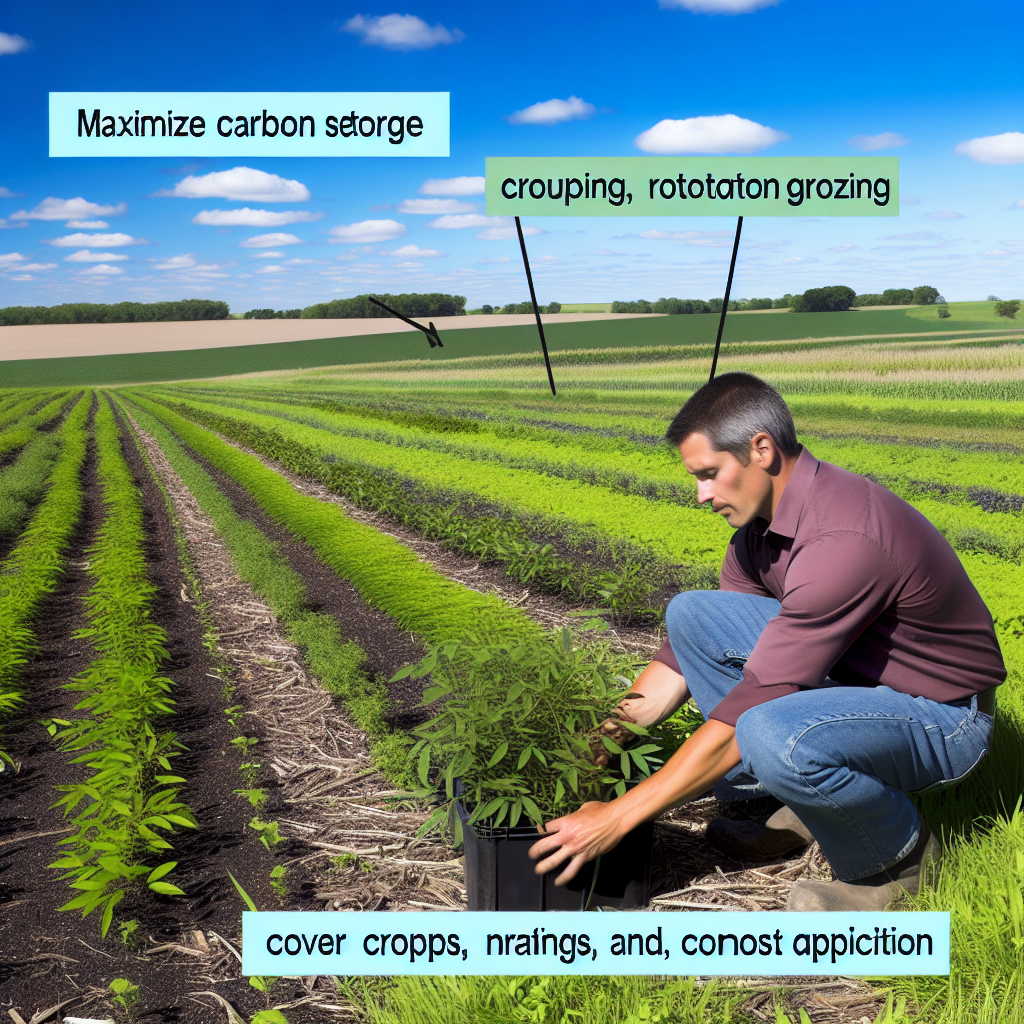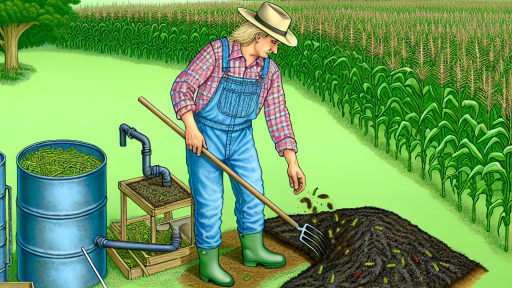Understanding the Role of Carbon Storage in Agriculture
Importance of Carbon Storage
Carbon storage plays a vital role in agriculture.
It helps mitigate climate change by absorbing carbon dioxide.
Farmers can enhance soil quality and fertility through carbon sequestration.
This process supports plant growth, leading to better yields.
Furthermore, it aids in water retention, reducing the need for irrigation.
Benefits of Enhanced Carbon Storage
Improving carbon storage can have various benefits for agriculture.
First, it increases soil organic matter, promoting healthier ecosystems.
Healthy soils lead to enhanced resilience against pests and diseases.
Additionally, higher carbon levels in the soil improve nutrient cycling.
Farmers can also experience economic gains through stable crop production.
Strategies for Maximizing Carbon Storage
Several effective strategies exist for enhancing carbon storage on farms.
- Adopting no-till or reduced-till farming practices.
- Implementing cover cropping to protect and enrich the soil.
- Incorporating agroforestry techniques, combining crops and trees.
- Utilizing compost and organic amendments to enrich the soil.
Each of these strategies contributes to increased carbon sequestration.
Community and Policy Support
Community engagement and supportive policies are critical for success.
Farming cooperatives can provide education and resources for farmers.
Government incentives may encourage sustainable practices on agricultural lands.
Transform Your Agribusiness
Unlock your farm's potential with expert advice tailored to your needs. Get actionable steps that drive real results.
Get StartedNGOs often play a role in promoting carbon farming initiatives.
Public awareness campaigns can create demand for sustainably produced goods.
Techniques for Enhancing Soil Health and Carbon Sequestration
Building Soil Organic Matter
Increasing organic matter in soil enhances its structure.
This process improves water retention in agricultural fields.
Farmers can achieve this by adding compost regularly.
Additionally, cover crops also help to boost organic matter.
These practices promote healthy microbial activity in the soil.
Implementing No-Till Farming
No-till farming reduces soil disturbance significantly.
This technique enhances carbon sequestering in the soil.
It also helps maintain soil moisture and texture.
Farmers can adopt this approach by using specialized equipment.
Over time, they will observe improved crop yields and soil quality.
Diversifying Crop Rotations
Diversifying crop rotations boosts soil health and resilience.
This practice reduces pest and disease pressures on crops.
Moreover, it enhances nutrient cycling within the soil.
Farmers can select cover crops that complement their main crops.
Such practices lead to better overall soil vitality.
Utilizing Agroforestry Practices
Agroforestry integrates trees into crop systems effectively.
This method enhances carbon storage in both soil and biomass.
Trees also improve biodiversity within agricultural landscapes.
Farmers can use tree canopies to protect crops from extreme weather.
Integrating trees can lead to healthier ecosystems and improved yields.
Enhancing Soil Microbial Activity
Microbial activity is vital for nutrient cycling in soil.
Farmers can enhance this by applying organic mulches.
Showcase Your Farming Business
Publish your professional farming services profile on our blog for a one-time fee of $200 and reach a dedicated audience of farmers and agribusiness owners.
Publish Your ProfileThis practice encourages beneficial microorganisms to thrive.
Increased microbial activity can improve soil fertility significantly.
Consequently, crops benefit from improved nutrient availability.
Incorporating Biochar into Soil
Biochar improves soil structure and enhances its carbon storage capacity.
This practice reduces nutrient leaching and increases soil fertility.
Farmers can create biochar from agricultural waste materials.
Using biochar helps in sequestering carbon and improving soil health.
Additionally, it provides a habitat for beneficial soil organisms.
The Impact of Crop Rotation on Carbon Storage Efficiency
Understanding Crop Rotation
Crop rotation involves alternating different crops in a specific sequence on the same land.
This practice enhances soil health and promotes biodiversity.
Farmers can reduce pest and disease risks by rotating crops.
As a result, soil fertility improves, leading to better yields.
How Crop Rotation Affects Carbon Sequestration
Crop rotation contributes significantly to carbon storage in agricultural soils.
Diverse crops create varied root structures.
These root systems help to build organic matter in the soil.
Increased organic matter enhances the soil’s ability to store carbon effectively.
Benefits of Crop Diversity
Diverse crop rotations reduce the dependence on chemical fertilizers.
Soil microbes thrive in diverse environments, boosting carbon retention.
Additionally, different crops absorb unique nutrients, improving soil structure.
Thus, farmers experience long-term benefits through increased carbon stability.
Successful Crop Rotation Examples
- Legume rotations enhance nitrogen levels in the soil.
- Root vegetables may help break up compacted soil layers.
- Cereal crops contribute to greater biomass return to the soil.
Farmers can observe significant improvements in carbon storage using these practices.
Challenges in Implementing Crop Rotation
Some farmers resist changing traditional practices.
Market demand may dictate certain crop choices, limiting diversity.
Additionally, transitioning to new crops requires education and resources.
Nevertheless, education programs can facilitate successful crop rotations.
Delve into the Subject: Planning Diverse Crop Sequences for Sustainable Yields
Utilizing Cover Crops to Boost Carbon Capture
Defining Cover Crops
Cover crops are plants grown primarily for soil health benefits.
They are not meant for harvest as a cash crop.
Farmers use cover crops to improve soil structure and fertility.
Additionally, these crops help prevent soil erosion.
Enhancing Carbon Storage
Cover crops play a crucial role in enhancing carbon storage.
They capture carbon dioxide from the atmosphere and store it in the soil.
This process is essential for combating climate change.
Moreover, cover crops increase organic matter in the soil.
As organic matter decomposes, it releases nutrients beneficial for plant growth.
Selecting the Right Cover Crops
Choosing the right cover crops is vital for success.
Diverse options include clover, rye, and vetch.
Each type offers unique benefits tailored to specific soil conditions.
Farmers should consider local climates and soil health when selecting crops.
Implementing Cover Crop Practices
Effective implementation of cover crops requires planning.
Showcase Your Farming Business
Publish your professional farming services profile on our blog for a one-time fee of $200 and reach a dedicated audience of farmers and agribusiness owners.
Publish Your ProfileFarmers should incorporate cover crops into their crop rotation strategies.
Timing is crucial for planting and terminating these crops.
Proper management leads to optimal growth and nutrient capture.
Measuring Carbon Benefits
Assessing the carbon capture benefits of cover crops is essential.
Farmers can monitor soil carbon levels with regular testing.
Documentation helps track improvements over time.
Additionally, metrics such as biomass production contribute to evaluations.
Challenges and Solutions
Farmers may face challenges when utilizing cover crops.
Some may worry about potential competition with cash crops.
However, proper management reduces this risk significantly.
Combining cover crops with cash crops can maximize land use.
Education and resources are also key in overcoming challenges.
Learn More: Cover Crops For Soil Regeneration Strategies
Integrating Agroforestry Practices for Improved Carbon Storage
Defining Agroforestry
Agroforestry combines agriculture with forestry practices.
This integration enhances carbon storage on agricultural lands.
It supports biodiversity while improving land productivity.
Benefits of Agroforestry
Agroforestry practices mitigate climate change through carbon sequestration.
They improve soil health by enhancing its structure and fertility.
Additionally, agroforestry increases water retention in the soil.
This leads to more resilient agricultural systems.
Farmers can diversify their income through the sale of timber and fruits.
Implementing Agroforestry Practices
Farmers can implement several agroforestry methods easily.
Alley cropping is one effective technique.
In this method, farmers plant crops between rows of trees.
The trees provide shade and improve microclimates.
Conservation Agroforestry
This practice focuses on conserving soil and water resources.
It involves planting trees along field borders and waterways.
The roots of these trees stabilize soil, reducing erosion.
Silvopastoral Systems
Integrating livestock with trees is another viable method.
Silvopastoral systems enhance both animal welfare and pasture quality.
This practice promotes a sustainable cycle of nutrient transfer.
Case Studies of Successful Implementation
Globally, farmers have successfully integrated agroforestry.
A project in Kenya showcases the effectiveness of agroforestry methods.
It has improved food security while sequestering significant carbon.
Challenges and Considerations
Despite the benefits, challenges remain with agroforestry adoption.
Farmers may face initial costs for setting up agroforestry systems.
Furthermore, knowledge about best practices can be lacking.
Educating Stakeholders
Education is crucial for successful agroforestry implementation.
Farmers should receive training on the best practices available.
Collaboration with agricultural extension services can enhance understanding.
Showcase Your Farming Business
Publish your professional farming services profile on our blog for a one-time fee of $200 and reach a dedicated audience of farmers and agribusiness owners.
Publish Your ProfilePolicy Support
Policy frameworks can facilitate the adoption of agroforestry.
Governments should offer incentives for farmers embracing these practices.
This support encourages widespread implementation.
Future Directions in Agroforestry
The future looks promising for agroforestry in carbon storage.
Innovative research continues to improve agroforestry practices.
New technologies are emerging to enhance monitoring and management.
These advancements will help maximize the potential of agricultural lands.
You Might Also Like: Native Plant Integration in Agricultural Systems

The Importance of No-Till Farming in Carbon Sequestration
Overview of No-Till Farming
No-till farming eliminates the need for tilling the soil.
This method reduces soil disturbance and maintains its structure.
As a result, it fosters a healthier ecosystem for microorganisms.
Moreover, no-till farming enhances water retention in the soil.
Mechanisms of Carbon Sequestration
No-till practices contribute significantly to carbon sequestration.
The reduced disturbance allows organic matter to accumulate.
This organic matter is vital for capturing atmospheric carbon dioxide.
In addition, healthy soil binds carbon more effectively.
Consequently, carbon remains stored in the soil for extended periods.
Benefits for Soil Health
No-till farming improves soil health across various metrics.
Increased soil organic matter enhances fertility and nutrient cycling.
Additionally, earthworm populations benefit from reduced soil disruption.
Furthermore, soil structure is better maintained, which aids drainage.
Impact on Crop Yields
No-till farming can lead to higher crop yields over time.
Healthy soil optimizes conditions for root growth and nutrient uptake.
Farmers often see reduced erosion, which enhances productivity.
This practice can also increase resilience against drought.
Economic Considerations
No-till farming can be a cost-effective method for many farmers.
Reduction in equipment use lowers fuel costs and machinery wear.
Moreover, it can enhance marketing opportunities through sustainability efforts.
Farmers may qualify for financial incentives or grants as well.
Challenges and Considerations
Despite its benefits, no-till farming poses some challenges.
Weed management is often more complex without regular tilling.
Farmers must adopt effective weed control strategies to compensate.
Additionally, transitioning to no-till may require an initial investment.
Supporting Research and Case Studies
Numerous studies highlight the effectiveness of no-till methods.
Research shows increased carbon storage in various agricultural systems.
Case studies demonstrate successful transitions for several farming operations.
Farmers report positive outcomes in both economic and environmental aspects.
Delve into the Subject: Soil Testing Methods For Better Farm Yields
Measuring and Monitoring Carbon Storage in Agricultural Systems
Importance of Accurate Measurements
Accurate measurements of carbon storage are essential for assessing agricultural practices.
These measurements help farmers implement effective carbon management strategies.
Showcase Your Farming Business
Publish your professional farming services profile on our blog for a one-time fee of $200 and reach a dedicated audience of farmers and agribusiness owners.
Publish Your ProfileFurthermore, they provide critical data for policymakers and researchers.
Methods for Measuring Carbon Storage
Several methods exist for measuring carbon storage in soil.
One common method involves soil sampling and analysis.
This process assesses the organic carbon content of soil layers.
It allows for tracking changes over time.
Remote sensing technology also aids in estimating carbon stocks.
This technology provides data on land cover and vegetation health.
Moreover, it can enhance monitoring across large areas.
Tools for Monitoring Carbon Changes
Farmers can utilize various tools for ongoing carbon monitoring.
Soil sensors measure moisture and temperature levels.
These parameters affect carbon cycling processes in the soil.
Additionally, digital platforms offer user-friendly interfaces for tracking carbon data.
Satellite imagery provides a broader perspective on land use changes.
This imagery helps identify trends in carbon storage over longer periods.
Challenges in Accurate Measurement
Despite advances, challenges remain in accurately measuring carbon storage.
Variability in soil types can affect measurement consistency.
Climate conditions also influence carbon dynamics.
Moreover, the lack of standard protocols can lead to discrepancies.
Addressing these challenges requires collaboration among scientists, farmers, and policymakers.
Future Directions in Carbon Measurement
Innovations in technology will drive future improvements in carbon measurement techniques.
Integrating artificial intelligence can enhance data analysis capacity.
This integration will lead to more accurate predictions of carbon storage potential.
Research will also focus on developing standardized protocols.
Such protocols are essential for ensuring consistency across different agricultural systems.
Ultimately, enhanced measurement techniques support sustainable agricultural practices.
They play a vital role in informing land management decisions and policy development.
Policy Frameworks to Support Carbon Storage in Agriculture
Importance of Carbon Storage Policies
Effective policies are crucial for maximizing carbon storage on agricultural lands.
Such policies can incentivize sustainable practices among farmers.
Moreover, they can lead to significant reductions in greenhouse gas emissions.
Types of Supporting Policies
Governments can implement various policies to enhance carbon storage.
These include financial incentives, regulatory frameworks, and technical support.
- Financial incentives encourage farmers to adopt carbon-friendly practices.
- Regulatory frameworks set standards for carbon emissions and storage.
- Technical support provides resources for implementing innovative practices.
Successful Examples from Around the World
Countries have seen success in implementing carbon storage policies.
For instance, Germany offers subsidies for cover cropping and reduced tillage.
Additionally, New Zealand utilizes a cap-and-trade system for agricultural emissions.
These examples highlight the potential of well-designed policies to drive change.
Collaboration Between Stakeholders
Collaboration among various stakeholders is essential for effective policy implementation.
Farmers, government agencies, and non-profits must work together.
Each stakeholder brings unique perspectives and resources to the table.
Monitoring and Evaluation Mechanisms
Monitoring and evaluation are vital to assess policy effectiveness.
Regular assessments help identify successes and areas for improvement.
Showcase Your Farming Business
Publish your professional farming services profile on our blog for a one-time fee of $200 and reach a dedicated audience of farmers and agribusiness owners.
Publish Your ProfileAdditionally, transparent reporting fosters trust among stakeholders.
Future Directions for Policy Development
Future policies should aim for flexibility and adaptability.
They should consider regional differences in agricultural practices.
Furthermore, integrating science and technology can drive innovation.
This approach will enhance the effectiveness of carbon storage initiatives.
Additional Resources
How to Sustainably Feed 10 Billion People by 2050, in 21 Charts …
Maximizing soil organic carbon stocks under cover cropping …




